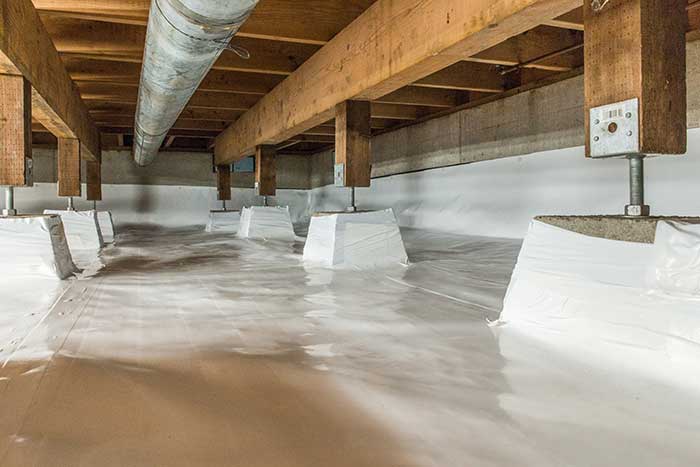The health of your home depends on a sealed crawl space. From energy efficiency to healthy air it is imperative to have healthy crawl space. Find out why here.

Don’t buy it if it doesn’t have a basement! That’s the cry of children everywhere when their parents start shopping for a new home. At least that’s what we said when our parents shopped for a home.
We wanted our own place where we could play hide-and-seek- and build blanket forts without our parents bothering us.
Basements have been around for centuries but grew in popularity in the U.S. starting in the 1950s. Today, roughly 30% of new homes come with a basement.
What about crawl spaces? “Get us a house with a crawl space,” said no child ever. And yet, the national average shows 15% of new homes have one.
If crawl spaces give you the creeps, you’re not alone. But sometimes you can’t avoid them, especially if you fall in love with a cute little house with the hidden space underneath.
Maybe you’ve heard rumors about crawl spaces and how you should make sure the house you bought has a sealed crawl space. Confused yet?
Let us help clear a few things up. Continue reading and find out what’s really going on down there. And see if you don’t side with us in the argument over should a crawl space be sealed or not.
The Hidden Space
If you live in a home with a crawl space, you may wonder who came up with the bright idea of creating a space under a house that has no practical use. You can’t stand up in it unless you’re a very small child. Unless you enjoy crawling around in damp musty places, you can’t store anything in it.
It’s not so much a question of who invented the crawl space but why did someone think crawl spaces were a good idea in the first place.
A crawl space raises a house off the ground. For homes built in damp areas, a crawl space makes sense, right? Moisture coming up from the ground stays in the space leaving your home protected from water damage.
The theory sounds great but as you’ll see later, your home may not be as protected as you think.
A crawl space also hides ductwork and plumbing. You don’t have to look at them but can get easy access when needed.
Crawl spaces cost less than a basement, which can be a huge positive.
Crawl spaces offer several enticing features—protection from flooding, easy access, and low cost. Unfortunately, crawl spaces can also be a source of health and safety issues—unless they’re sealed.
Crawl Space Science
The crawl space is the lowest point of your home. Air from the crawl space rises and flows up into your living spaces. About 50% of the air you breathe (on the first floor) comes from the crawl space.
When crawl space air rises, replacement air, which consists of outside air, comes through the crawl space vents. Replacement air also seeps in through leaks in the joists and other unsealed areas.
The air rising from the crawl space isn’t filtered and purified on the way up. It often contains moisture and mold spores. And if you have a dirt crawl space with open vents, you have a constant source of moisture.
Warm and Cozy in Northwest
Between the polar vortex and back-to-back snowmakers delivering a wallop to most of the country, if you like the cold, you’re happy this winter. If you have a crawlspace, you’ll find plenty of frigid air there too.
During the winter a crawl space fills up with cold air. Because your ductwork and water pipes reside down there, the cold air cools them too. Your hot water heater and furnace end up working harder and wasting energy.
If you have a leaky duct system cold crawl space air gets sucked directly into the heating vents. You may see a 20-30% increase in heating costs.
That cold air from the crawl space rises and makes your floors cold too.
Is the argument for a sealed crawl space getting stronger?
Warm floors and lower heating costs both make a strong case but is winter the only season where an unsealed crawl space causes problems?
A Summer Space
Remember what we mentioned earlier about the crawl space being a source of constant moisture. During the summer when humid air flows into the crawl space condensation forms on any cool surface including pipes and wood.
When you live in the Pacific Northwest, you don’t need help creating high moisture levels in your house. If your crawl space has a system of open vents, you can bet you not only have high moisture levels but you also have high mold counts. Moisture and mold make excellent friends.
Mold spores travel through the air rising from the crawl space and land in your respiratory system. If you have unexplained allergy symptoms, or worse, asthma, mold may be the culprit.
And those leaky ducts that pull cold air in and push it out to your living spaces before it can go through the furnace? They work the same way in the summer only now they suck in the hot, humid air and spit it out upstairs before your air conditioner can cool it.
In addition to potential physical health problems, moisture from the crawl space can cause rotting of the wood structures in your home. You rely on your home’s structural integrity for your physical safety.
If the moisture and the mold aren’t convincing enough consider the wildlife.
Critters Love Crawl Spaces
Don’t let the thick layer of concrete fool you—critters are clever and they have no problem getting in and staking a claim in your crawl space.
Rats and mice are common squatters but people also find possums, squirrels, skunks, and snakes making themselves welcome. Considering how dark it is in a crawlspace, don’t be surprised if you find a colony of bats living in yours.
Like some children, rodents don’t clean up their mess. Instead, they leave behind droppings, which eventually affect air quality inside your home. They may even chew on exposed wiring, shred insulation (they use it for their nests), or tear a hole in your vapor barrier.
They can get in through the smallest hole but if you haven’t taken care of sealing crawl space vents, you’ve essentially put out the welcome mat.
The Modern Crawl Space
Building science has come a long way since the early days of basement and crawl space technology.
In the old days, homes were designed with an open or vented crawl space. Now builders know sealing crawl space vents means you have more control over moisture entering from outside.
When you seal you reduce moisture in the crawl space, which protects your home’s structural integrity by lessening the likelihood of wood rot developing.
Sealing off vents also blocks access to rodents and other pests who are looking for a home.
You may also see improvements in your physical health. Removing allergens such as mold improves indoor air quality. You’ll breathe better and possibly decrease the number of respiratory illnesses you get every year.
Ready for a Sealed Crawl Space?
Hopefully, we’ve helped identify some key reasons why updating your home with a sealed crawl space makes sense.
Most people look for ways they can save money on heating and cooling bills. This may be your solution.
If you’re not enjoying good physical health because you fight with an inhaler and take allergy medication, improving your air quality should mean better health.
No one wants a bunch of rodents living underneath them and since the primary way they get inside the crawl space is through the unsealed vents, why not go ahead and yank the welcome mat right out from underneath them?
Enjoy these benefits and more when you invest in a closed crawl space!
Contact us today and schedule a consultation. We look forward to meeting you.
